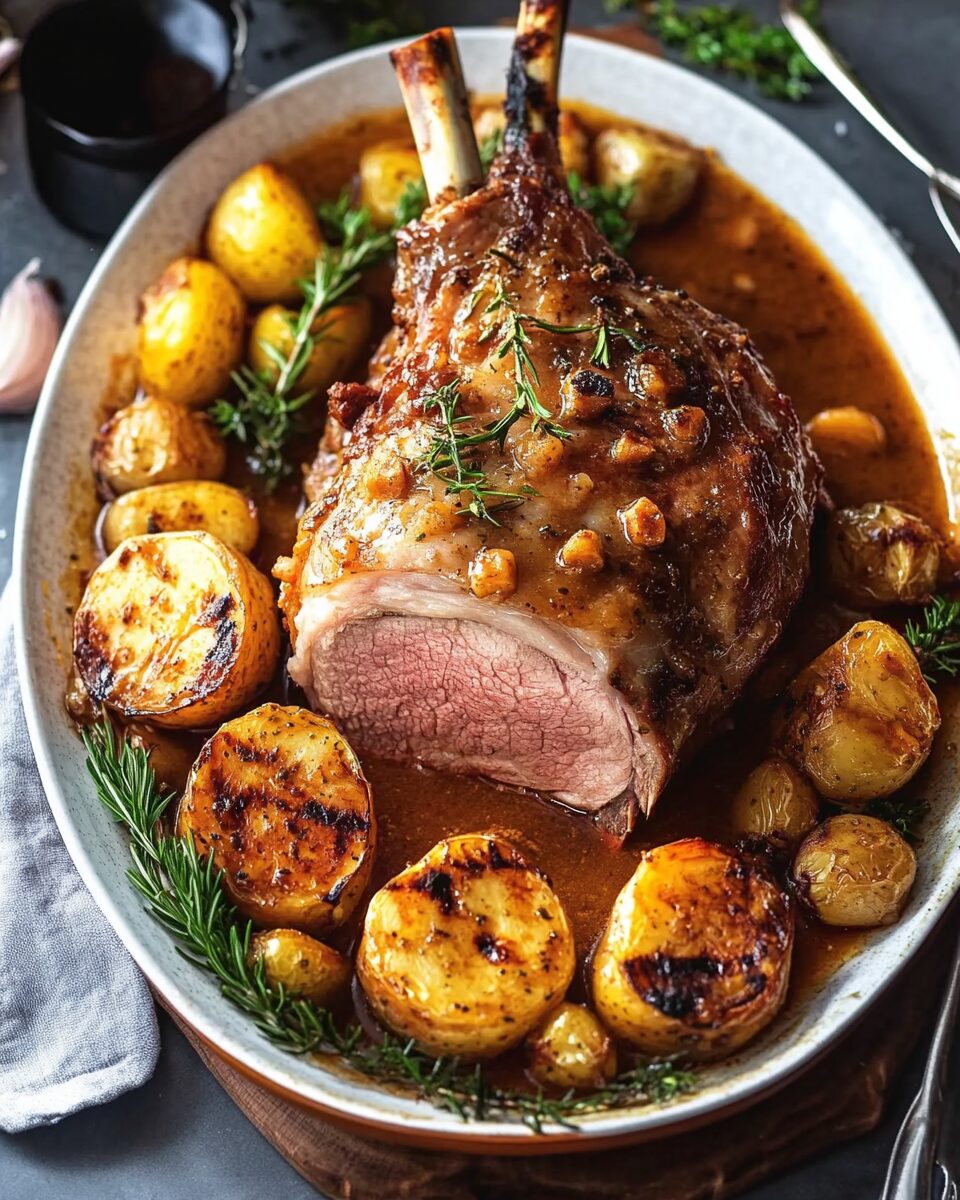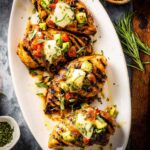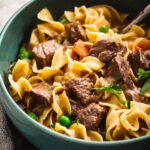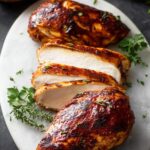The rich aroma of rosemary and roasted garlic fills the kitchen as this majestic lamb leg bakes to golden perfection. The key to its juicy, blushing-pink center is a simple meat thermometer, making this dish both foolproof and elegant.
Paired with a deeply flavorful gravy made from savory pan drippings and mashed caramelized garlic, this dish elevates any gathering. Whether served with duck fat roast potatoes or classic veggies, it’s bound to be the highlight of your meal. A true celebration of flavor and comfort, all in one roasting pan.
Full Recipe:
Lamb:
-
2.75–3 kg (5.5–6 lb) bone-in lamb leg
-
1½ tsp cooking salt
-
½ tsp black pepper
Rub:
-
1½ tbsp fresh rosemary leaves, finely chopped
-
3 garlic cloves, finely minced
-
2 tbsp olive oil
Base:
-
2 whole heads garlic, halved horizontally
-
Few sprigs of rosemary (optional)
Gravy:
-
4 tbsp plain/all-purpose flour
-
2½ cups beef stock/broth, low sodium
Directions:
-
Remove lamb from fridge at least 1 hour before roasting to bring to room temperature.
-
Preheat oven to 240°C/475°F (220°C fan).
-
Mix rosemary, minced garlic, and olive oil in a small bowl to create the rub.
-
Place lamb in a roasting pan and coat thoroughly with the rub. Sprinkle evenly with salt and pepper.
-
Position the halved garlic heads (cut side up) and rosemary sprigs under the lamb.
-
Roast lamb for 20 minutes at high heat to brown.
-
Reduce oven to 200°C/400°F (180°C fan) and roast for another 1 hour or until internal temperature reaches 53°C/127°F for medium rare. Check temperature at 45 minutes.
-
Remove from oven, loosely cover with foil, and rest for 20 minutes to 1 hour.
-
While lamb rests, discard rosemary sprigs and heat the roasting pan on the stove.
-
Add flour to pan drippings and cook for 1 minute, stirring constantly.
-
Gradually whisk in beef stock, scraping up any browned bits.
-
Use a potato masher to crush garlic halves into the gravy. Simmer until desired thickness.
-
Strain gravy, pressing garlic to extract flavor. Serve alongside sliced lamb.
Prep Time: 15 minutes | Cooking Time: 1 hour 20 minutes | Total Time: 1 hour 35 minutes
Kcal: 450 kcal | Servings: 6–8 servings
The Legacy of Roast Lamb: A Time-Honored Tradition
Roast lamb is more than just a meal—it’s a culinary tradition steeped in history and celebrated across numerous cultures. From Mediterranean feasts to British Sunday roasts and Australian family dinners, lamb has held a central place at the table for centuries. The leg of lamb, in particular, is a prized cut known for its tenderness and flavor when properly prepared.
In Australia, roast lamb leg is a national treasure, often appearing at special gatherings, holidays like Easter, and even casual Sunday dinners. What sets it apart is not just the meat itself, but the method of preparation—a symphony of technique, timing, and aromatics. This particular recipe for Roast Lamb Leg with Rosemary Garlic and Pan Gravy captures the essence of classic lamb preparation while adding just the right modern touches to make it accessible for any home cook.
Why This Recipe Stands Out
What makes this roast lamb recipe exceptional isn’t just the flavor—it’s the thoughtful technique that ensures perfect results every time. First and foremost, the use of a meat thermometer is emphasized to eliminate the guesswork. This small tool is the secret weapon behind achieving the ideal internal temperature for lamb: a tender, juicy, pink-centered roast that is never overcooked or dry.
The rub—a blend of fresh rosemary, garlic, and olive oil—infuses the meat with earthy, aromatic depth. These are traditional flavors associated with lamb for good reason: rosemary’s pine-like notes complement the natural richness of the meat, while garlic adds warmth and savoriness.
This roast is also elevated by the simple but powerful pan gravy made from the meat’s own drippings, thickened with flour, and enriched with beef stock. The flavor is bold and complex without needing a long list of ingredients or fussy methods. It is the kind of gravy that lingers in your memory, perfect for spooning generously over sliced lamb and crispy roasted potatoes.
The Importance of Resting and Temperature Control
One of the most often overlooked steps in cooking roast meats is the resting period, but in this recipe, it’s treated as essential. Once the lamb reaches the ideal internal temperature—taken out at 53°C (127°F) for medium rare—the meat must rest for at least 20 minutes. During this time, the temperature continues to rise slightly due to carry-over cooking, settling at about 62°C (144°F), the sweet spot for medium rare.
Resting also allows the juices inside the lamb to redistribute. Cutting too early would result in dry slices and juices lost on the cutting board. By allowing a proper rest, the final result is consistently moist and flavorful.
This kind of temperature awareness is key for lamb leg, which is naturally lean. Unlike fattier cuts, lamb leg has less margin for error. Overcooking can quickly lead to dryness, especially near the outer edges. That’s why a thermometer is so crucial—what may seem like a small detail can make or break the dish.
Flavor Development Through Simple Techniques
There’s an art to roasting meat that goes beyond simply setting the oven. In this recipe, flavor is developed at every stage. Starting with a high heat blast for the first 20 minutes ensures a beautiful, caramelized crust that locks in juices. Reducing the oven temperature afterward allows the meat to cook gently and evenly, avoiding the dreaded “gray ring” of overcooked meat around the edges.
Another ingenious touch is the use of a garlic and rosemary bed beneath the lamb. Not only does it help elevate the meat for better heat circulation, but the drippings also absorb the flavor of the aromatics as they caramelize. These flavor-rich drippings then become the base of the pan gravy, creating a sauce that’s infused with roasted garlic sweetness and herbaceous depth.
Choosing the Right Cut and Quality of Lamb
As with any meat-focused dish, ingredient quality matters. While you can certainly find lamb legs in supermarkets, sourcing from a local butcher often yields better flavor and texture. Look for lamb with a deep red hue and a nice balance of fat around the muscle. This not only improves the final taste but also reflects a better quality of life for the animal.
Bone-in lamb leg is preferred in this recipe not just for tradition, but because bones help insulate the meat and contribute to more even cooking. They also add to the overall presentation—especially for special occasions where visual impact matters.
If you do end up with a boneless leg, don’t worry. You can still follow the same rub and cooking method, though cook time may need adjusting slightly. Just be sure to unroll the lamb if it’s tied, apply the rub inside and out, then tie it back up for roasting.
Gravy: The Crown Jewel
No roast lamb is complete without a good gravy, and this recipe delivers one of the best. Made directly in the roasting pan after removing the lamb, the gravy uses every bit of the flavorful fat and browned bits left behind. A touch of flour thickens the sauce, and beef stock adds depth and umami.
One of the more unique techniques here is mashing the roasted garlic directly into the gravy. The sweetness of roasted garlic not only boosts flavor but also softens any overly sharp notes in the sauce. After simmering and thickening, the gravy is strained to ensure a silky, restaurant-quality finish.
The result is a sauce so good, it could be served on its own. It pairs perfectly not just with lamb, but also with roasted vegetables and potatoes, making it an integral part of the overall dish.
Serving Suggestions and Sides
Traditionally, roast lamb is served with duck fat potatoes or classic crispy roast potatoes. The richness of the lamb and gravy pairs wonderfully with the golden crunch and fluffy interior of roasted spuds. Add to that some steamed buttered carrots, garden peas, or braised greens, and you have a complete, comforting plate.
A glass of robust red wine—like Shiraz, Cabernet Sauvignon, or even a rich Pinot Noir—completes the experience. These wines complement the savory richness of the lamb without overpowering the delicate herbal notes from the rub.
For a special touch, you could also serve a mint yogurt or tzatziki on the side, especially if you’re serving the lamb at a springtime or Easter feast.
Perfect for Every Occasion
What makes this roast lamb recipe so versatile is that it works equally well for casual Sunday dinners and elegant holiday spreads. It’s easy to scale up for a larger group, and leftovers are phenomenal—think lamb sandwiches with gravy, or lamb hash with roasted vegetables the next morning.
This recipe also lends itself to customization. You could experiment with adding crushed fennel seeds, lemon zest, or even Dijon mustard to the rub for a unique twist. Or infuse the gravy with a splash of red wine for added richness.
Conclusion: A Roast to Remember
This Roast Lamb Leg with Rosemary Garlic and Pan Gravy recipe is more than just another meal—it’s a celebration of classic flavors and timeless techniques. With a few simple but intentional steps, you can achieve restaurant-quality results in your own kitchen. The focus on proper temperature, quality ingredients, and thoughtful flavor building makes it a reliable go-to for any occasion.
Whether you’re a seasoned home cook or a beginner eager to impress, this dish delivers every time. From the beautifully browned crust to the succulent pink center and luscious gravy, every bite tells a story of care, tradition, and culinary joy.





